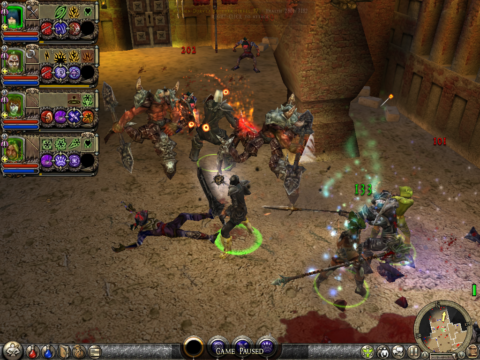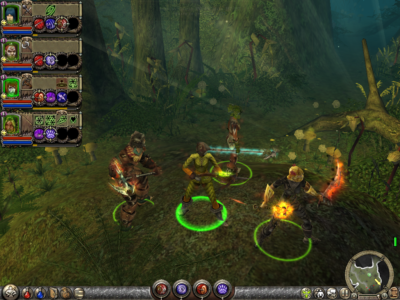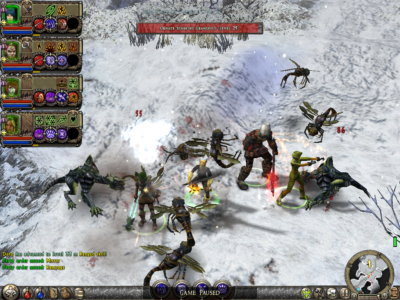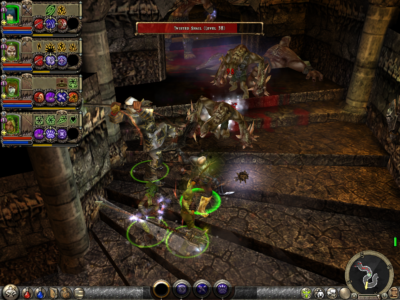
Dungeon Siege 2
Written by: Stoo
Date posted: February 11, 2022
- Genre: RPG
- Developed by: Gas Powered Games
- Published by: Microsoft Game Studios
- Year released: 2005
- Our score: 7
The action RPG Dungeon Siege, created by Gas Powered games and released in 2002, doesn’t feature any actual sieges. You don’t spend months sat outside a dungeon (or anywhere else) that has been encircled by your army, cutting off the occupants supply lines and starving them into submission. You do run into places and swiftly annihilate everyone inside, which isn’t really a siege. That would be more like “dungeon assault”.
My dreadful pedantry aside, what Dungeon Siege does have is a focus on the simple goals of fighting monsters, defeating evil and gathering shiny loot. Designer Chris Taylor set out to create an RPG that was straightforward and streamlined, with an emphasis on action. It was hoped it could appeal to a wide range of gamers, not just veteran goblin-botherers. To this end chores and frustrations that might slow you down were cleared away.
So, for example you didn’t need to pour through manuals or internet forums learning about character classes. You just jumped straight in and started slaying monsters. The more you swung a sword, or shot arrows, or cast spells, the more proficient your character became in that form of combat. Dead simple. Also there was no trudging around wildernesses looking for monsters and magic macguffins. Instead the entire game was strung out along one linear path, so you were always moving onwards to the ultimate goal.
It was both inspired by, and in direct competition with, the Diablo series which more or less marked the start of modern action-RPGs. In contrast with Blizzard’s games, Dungeon Siege offered control of a party of up to 8 people instead of just one hero, supposedly offering the potential for a bit of tactical thinking. It also featured a fully 3D engine, with proper spinny-rotating-o-vision (that’s the techncial term for being able to move the camera around), highly impressive compared to Diablo 2’s oldschool isometric view.
Ultimately D2 proved the more influential game, giving rise to the likes of Titan Quest and Torchlight. It also enjoyed greater longevity, with fans on multiplayer right up until its re-release last year. For my own part, I found Dungeon Siege entertaining but repetitive, an endless cycle of clicking to kill monster, gather loot, move on repeat. Also I can tell you basically tell you nothing about the lands of Aranna or the bad guy we fought; the story was entirely forgettable, as if it had been strung around the action like an afterthought.
That said, it clearly did something right; not only did it spawn two sequels but also the Space Siege spinoff, which Rik reviewed a few years back. So here I am with the second game, finally contributing another RPG review to this humble site.
In this first sequel, our enemy is Valdis, a mighty warlord. You can tell he’s bad because of his spiky armour, and his army who look like they marched straight out of Mordor. They’re even called Mordor. Well, Morden. Anyway. He’s found some ancient and powerful sword, and is on a mission conquer the world and bring about a great catastrophe. You must find a magic shield which was once used to stop the last guy who had the sword, but is now shattered into pieces.
Or something like that. It’s a barebones and formulaic story about prophecies, a Big Bad, new ages of darkness etc. Also much of the lore describing the history and people of this land is safely tucked away in the form of text in a journal where you can completely ignore it. I had to run off to google just to figure out if it even takes place in the same world as the first game (apparently: yes it does).
Still, if I can remember the name of the Big Bad, writing this a few weeks after I finished the game, we’re already one doing better than the first game. Also, this time around, the world does feel somewhat more alive, and I came away with a better sense of what I was meant to be fighting for. I should acknowledge some players might not even care – we’re here to kill stuff, level and loot right? Well, I’ve never been much of a power-gamer, and I like to immerse myself in fictional worlds. So this is just my take. Reviewing is a subjective business!
Anyway, the game benefits from some key changes to the layout of its world and your path through. Before, each town was a place you rocked up to, did a few chores, then charged out the other side never to return. Hi guys! Want any of these goblin swords I picked up? Let me buy that hat. See ya! It was perhaps an example of too much streamlining; your time in any outpost of civillsation was so fleeting, none of them had any real signifance.

It’s a lovely day for a stroll through the forest.
Now there are three towns, each serving as a hub for your activities. You return to them regularly to sell loot, buy spells etc. You also pick up side-quests from the people here and return to report your success afterwards. In this way, you gain a sense of familiarity with the places and the folks who live there. There’s the reclusive Dryads, who’s arboreal city is encircled by Valdis’ forces (so I guess there is a siege here, just not of a dungeon). Or a human city in the desert, currently occupied by the Morden, their young lord weighing desire for freedom against need to keep his people safe.
Just to be clear this is all stuff that’s routine in other RPGs. Report to town. Exchange a few lines with a surly blacksmith. Go on quest to find a magic turnip for the eccentric old guy. However, it was all missing from the first game, and I don’t think it slows the action down unduly to put it all back. These are the people you’ve come to save, oh valiant hero. It’s worth at least slowing coming back every so often to have a chat and offer your heroic services.
Meanwhile, unlike your first time around, your own party members actually have something to say. Perhaps the GPG people noticed how in Baldur’s Gate your heroes didn’t spend the entire game in stony silence. Okay that wasn’t an action-rpg but again, it’s not breaking the ethos of that subgenre to give your team the outline of a personality. It’s the difference between a band of heroes who come together to join your cause, and a bunch of anonymous automatons.
Each town serves one of the three regions into which the game’s world is divided. As you’d pretty much expect your adventures cross through a whole bunch of different landscapes. The first realm has you running around the floor of a huge verdant forest, later on you cross icy peaks and dusty deserts. They all look fine, as do the character models. A bit low-poly maybe, and I’m sure modern games have all sorts of fancy effects for the dappling of light through a canopy of leaves or whatever. I haven’t really kept up. All I can say is I went in with my expectations tuned to 2005, and my sense of aesthetics was not offended.
The engine certainly doesn’t give you any problems or frustrations controlling your spinny-rotating view. It will also let you zoom in from your overheard perspective, down to right up close to the action. In the middle of combat this is absolutely useless for any sort of situational awareness or control of your party. It is however, fun to get down ground level to see our heroes hacking away amidst a pit of hideous monsters.
So let’s move onto describing that action in more detail. As before you have a choice of melee weapons, ranged weapons, combat magic (mostly offense and some spells to debilitate enemies) and nature magic (a mix of offense, healing and party enhancements). Each form of combat has an associated skill levels that is raised by repeated usage, and grants access to more powerful weapons and armour. As skill rises, so does character level, alongside basic attributes like strength. These don’t require any sort of intervention or decision required from the player; just be assured a warrior guy’s strength will go up faster thn other attributes, a ranger will mostly get agility and so on.
However, this time around we see some influence from Diablo 2, in the form of skill trees. We’re all familiar with the idea now – every time a skill is raised you can spend a point on the associated tree. So you have choices like ice damage in Nature Magic, or increased critical hit chance in ranged combat. This process allows for further specialisation, within a skill. For example a melee character can focus on dual wielding (for a flurry of blows), two handed weapons (slower, heavier strikes with a chance of stunning foes) or 1-hand plus shield (harder to kill).
There are also special powers that are unlocked according to skill tree choices. These are separate to magic spells, and are recharged by killing stuff. Many of powers are devastating attacks, which you should save for the right moments for best effect. Wait for the monsters to line up before you, then click and boom, they go flying. Highly satisfying, but to use them again you need to get stuck right back in.
Your first character is your own avatar (so you have a few options to choose sex and appearance), and also a completely blank slate to become any sort of hero you wish. Others that you enlist are the premade NPCs and have one skill already raised up several levels. Although when you first recruit each one, their skill points are free to spend to so you can decide their exact specialisation. The game warns you to focus on one skill per character; you don’t want someone who divides their attention between two different fields but isn’t particularly good at either. That said, I found it can’t hurt for warrior types to dabble in a bit of nature magic to help with healing.
On your first run through the game, your team can have four active members, from a pool of eleven. That’s down from the first game’s eight, but enough for multiple configurations – one character of each skill, or maybe two burly warriors backed up by a ranger and nature magic. You can swap them out freely whenever you return to town (where inactive heroes loiter in the pub, of course) although your main hero must always be present. Higher difficulty settings, each unlocked by completing the previous one, give an additional character slot to help you against the tougher foes.
Any one active character can be chosen to fall directly under your control, and you can opt between two combat modes : the new one, where you click for each individual attack (Diablo Style), or just click once leaving them to keep swinging swords, loosing arrows, firing spells etc until the target is dead (DS1 style). For magic types, up to four spells can be put on a quick selection menu so you don’t have to keep pausing to root around through their full list.
Everyone else will behave in in one of two ways. In “mirror mode” they stay close to the selected character and attack the same target. If set to “rampage” they will loosely follow but also automatically move and attack anything within a certain radius. The chaos that ensues is a bad idea when you need to concentrate attacks and bring down tough foes one at a time. Where it’s both useful and slightly hilarious, though, is watching your guys charge off willy-nilly to annihilate large volumes of weak monsters.
The old party formations are more or less gone, but then they always looked like something that promised tactical depth but in fact had little impact. What I do miss, though, is the option to split the party and order individuals or subgroups to move to separate locations. It could be helpful to send one guy forward to lure a few enemies away from a large group for example. Also I found myself often wishing I could more easily keep squishy magic-users out of harms way; 90% of the time when getting overwhelmed by the enemy, my nature mage was the first to die. (And she was meant to be the healer!)
There are a few major boss fights along the way that are reasonably impressive, and punctuate the sessions of regular dungeoneering. None are exactly complex, they just require a modicum more thought to avoid getting wiped out. Given say a hyrda with multiple heads, each with different powers, maybe there’s a best order to try and kill them. Also watch out for spells that will insta-kill your guys (“don’t stand in the bad stuff”, we used to say in Warcraft).
Killing monsters and completing quests means loot, and the eternal quest for better gear is as core a part of arpg principles as clicking. In that Diablo style, weapons and armour are colour-coded to indicate increasing strength and rarity. Top-tier stuff only drops occasionally – and weirdly, when it comes its often for characters much lower level than yours. Save it for someone under-levelled and languishing back at the pub, I guess? Some gear comes in set (“Jeff’s garb of righteous smiting” etc) with extra bonuses depending on how many of the four or five bits you are wearing. So the more monsters you slay, the more chance you have of finding those elusive last parts and finishing a set.
There are further features to the game that add flavour and variety, but there doesn’t seem to be a huge incentive to make use of them. For example you can to fill a party slot with a pet creature instead of one of your characters. The creatures have unique powers and give boosts to the rest of the team such as fire magic resistance, but it didn’t seem worth losing the loss in fighting power. Maybe more appealing on higher settings when you have more slots.
Then there are special shrines where you can activate any one from a list of temporary buffs. I guess this should give you an edge in combat, but I’m not sure I noticed the difference. Also, I was sometimes just too lazy to flick through the list to decide on something that would fade away two minutes later. Again, perhaps something I’d look at more closely on hard mode.
Then there’s the crafting system, where otherwise mundane weapons and armour can be combined with artefacts to gain various bonuses. Problem is, nothing I could make seemed better than the gear I was getting the usual way. The best use I found was making rings and amulets to fill gaps in magic resistances (fire, ice etc); the sort of thing it’s easy to overlook when maximising more exciting things like weapon damage.
When collecting my thoughts on DS2 I’ve found myself bouncing between two different contexts, starting with comparisons to its predecessor It certainly puts more work into the world building than DS1, even if we’re not talking Blizzard levels of extensive lore. It also improves on the rather sparse character mechanics, getting you more involved in the progression of each hero. So it’s a more fully developed product. Also, even if it drifts a little from the minimalist philosophies of the original, it still moves along at a good clip. So I’d say it accomplishes all that I’d look for in a sequel.
Moving our view to the wider, generally Diablo-2-derived crowd, I start to tire with them when I find I’m stuck doing the same actions over and over. The same fireball, or axe-swing or whatever. Maybe a slightly better fireball after 20 levels. The only break is to start from scratch, unless you can freely re-specialise your character (something Diablo 3 got exactly right). That’s not an option here since choices are permanent, but you benefit simply from having multiple characters in play at once, and therefore more actions at your fingertips. Also there’s enough of them to try a couple different specialisations for each main skill, within a single run through the game. In other words, there’s a clear benefit to the full-party approach.
In any case all action RPGs share some basic qualities. They’re initially addictive due to the nature of their action and reward cycle. Click to attack, click to loot. They’re also repetitive because of that same endless cycle. At worst they become a chore. I found Titan Quest to be a joyless, mechanical slog, running around ancient Greece firing the same damn lightnining bolt. It really was not enhanced by consulting faqs and forums for the supposed best character builds, in fact it nearly killed my interest in these games. As for Diablo 2 itself I played it extensively back in the day, but I can’t bring myself to plod around those fields and caves in the first part for the twentieth time. That’s why we still don’t have a review up here.
I’m happy to say then that Dungeon Siege 2 is one that stays compelling, instead of laborious. I managed to get a bit attached to my little band of heroes, and watching them lay waste to hordes of bad guys rarely grew stale. I also remained duly devoted to the pursuit of ever shinier swords with plus 10 critical hit rating AND lightning damage. On top of that I found myself keen to complete all the side quests about finding someone a hat, or various other nonsense that we always pause fate-of-the-world stuff for. So there were definitely a few post-midnight sessions of this game. (increasingly a bad idea as I get older, and also have to get up promptly every morning to give my little girl breakfast).
That makes it one of my top choices for action RPGs from the 2000s. This one or Torchlight, which I recall enjoying several years ago and plan on revisiting soon. I realise it seems odd to proclaim it the best of its kind and then give a score of only seven but, as you’ve figured out by now, I’m not particularly enthusiastic about some of its peers. Also, maybe there are limits on a subgenre built around a lot of clicking to knock goblins down and take their stuff a thousand times over. Top marks in my mind go to RPGs that are innovative, or tell amazing stories, or craft truly immersive worlds. The likes of Deus Ex, or Planescape Torment, or Fallout 3. This is all a deeply subjective busines so, if you disagree, that’s fine!
For what it’s worth Diablo 3 would get an eight, it just misses the decade we’re looking at by a couple of years. Also, seven is not merely average, that would surely be five on a properly callibrated scale. Although honestly I’ve always struggled with applying a consistent scoring system on this site. So let’s just end by saying this: Dungeon Siege 2 provides some thoroughly satisying action with a robust system for character progression, it’s a great way to relax after a stressful day and it carries our solid recommendation.




 Posts
Posts